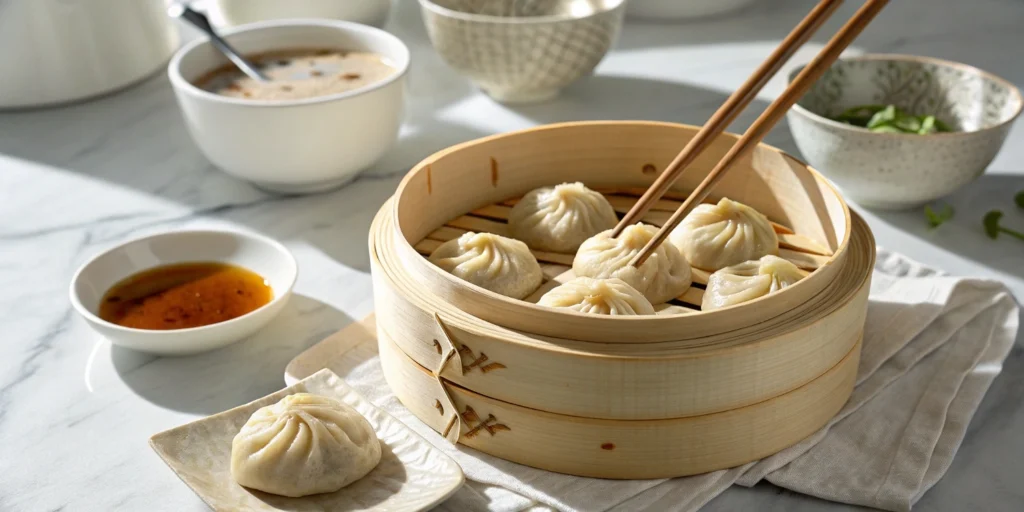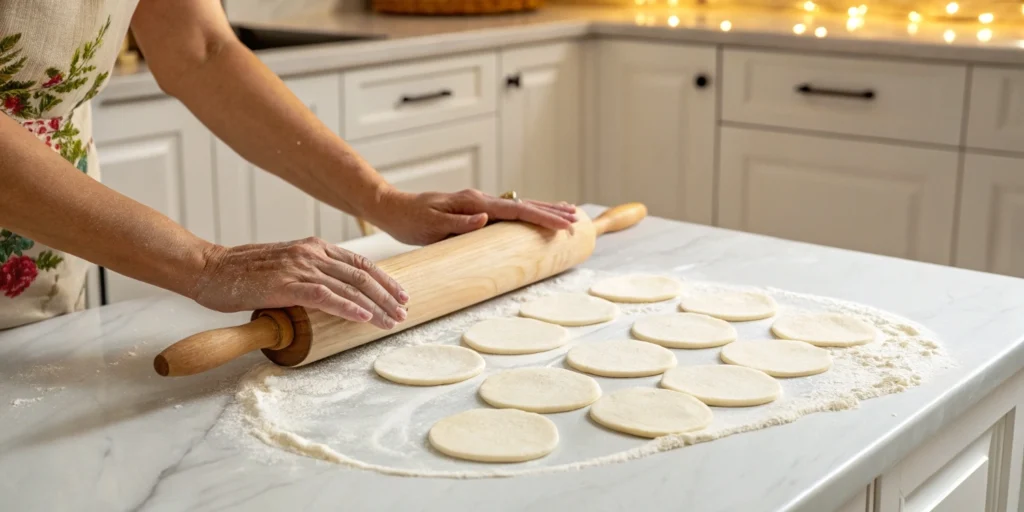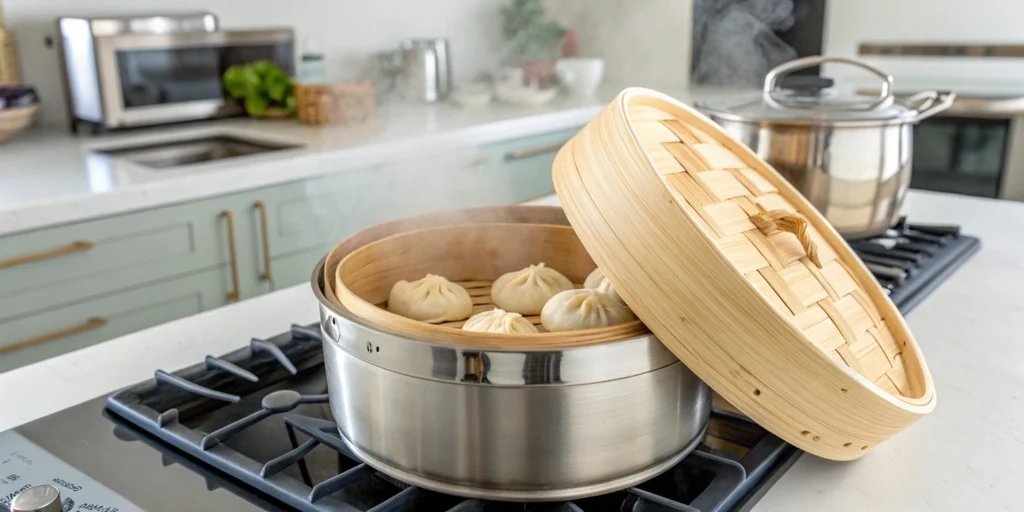
Table of Contents
A spoonful of warm soup encased in delicate dough, followed by a burst of savory pork filling—if that experience has ever made your day, you’re in the right place. Creating soup dumplings at home may seem like a culinary Everest, but with the right process, your kitchen becomes the heart of a dim sum haven.
You’re not just making dumplings; you’re unlocking a jackpot of flavor and skill.
Let’s walk through this together—one step at a time, from building the rich soup gelatin to that satisfying final bite.
What Sets Soup Dumplings Apart?
You’ve likely heard them called xiao long bao (小笼包)—a treasured dish that hails from Shanghai. Unlike traditional dumplings, these are filled with a savory broth that’s solidified into gelatin before being wrapped and steamed. The heat transforms the gelatin into a hot soup, giving you that incredible explosion of flavor with every bite.
What makes these dumplings stand out?
- Thin, pleated wrappers
- Juicy, seasoned meat filling
- A gelatin-based soup cube that melts into rich broth
- Served steaming hot with vinegar and ginger slices
That balance of flavor, texture, and warmth turns every bite into something you’ll crave again and again.
Jackpot Ingredients for Homemade Soup Dumplings
You’ll need three main components: a flavorful pork filling, collagen-rich soup gelatin, and smooth, stretchy dough. The good news? You probably have most of the ingredients in your pantry already.
For the Soup Gelatin (Aspic)
This is where the broth magic begins.
- 1 pound pork skin or pork bones (neck bones or trotters work great)
- 6 cups water
- 2 slices of ginger
- 2 green onions, cut in half
- 2 tablespoons Shaoxing wine
- 1 tablespoon soy sauce
- Salt to taste
Simmer everything together for about 3 hours. The collagen from the pork turns the broth into a jelly-like consistency once cooled. Strain it well, refrigerate until firm, and dice into small cubes.
Short on time? Mix 2 tablespoons of unflavored gelatin into 4 cups of rich, store-bought broth for a quicker version. It won’t have the same depth, but it gets the job done.
For the Dumpling Dough
This dough needs to be pliable yet strong enough to hold the soup inside.
- 2 cups all-purpose flour
- ¾ cup hot water (not boiling)

Add hot water to the flour slowly, mixing with chopsticks or a fork until a shaggy dough forms. Knead for 10 minutes until smooth, then let it rest under a towel for 30 minutes. That resting time lets the gluten relax, making it easier for you to roll thin wrappers.
For the Pork Filling
Here’s where richness meets balance.
- 1 pound ground pork (about 20–30% fat)
- 1 tablespoon soy sauce
- 2 teaspoons sesame oil
- 1 tablespoon Shaoxing wine
- 1 teaspoon sugar
- 1 teaspoon grated ginger
- 1 clove garlic, minced
- ½ teaspoon white pepper
- 1 teaspoon cornstarch
- ¼ teaspoon salt
Combine all the ingredients in a bowl. Once your aspic is ready and cubed, gently fold it into the meat mixture and chill. Keeping it cold ensures easy wrapping and prevents the gelatin from melting prematurely.
5 Steps to Juicy Perfection
1. Build the Broth Base (Soup Gelatin)
You want that soup to taste like it’s been simmering for hours—because it has. Simmer pork skin or bones with aromatics for a few hours until it’s rich and flavorful. Strain the broth and refrigerate it overnight. When it firms up, it should resemble savory Jell-O. Chop it into pea-sized cubes and keep it chilled until you mix it into the filling.
If you’re skipping the long simmer, just dissolve gelatin in heated broth (make sure it’s concentrated and well-seasoned), pour into a flat dish, and refrigerate.
2. Knead the Dough
You’ll notice the dough becomes smoother the more you work with it. Add hot water gradually and knead until it’s elastic and slightly tacky. Don’t skip the 30-minute rest—it’s crucial for texture. When ready, divide the dough into four equal parts and keep them covered as you work.
Roll each piece into a log, then cut into 1-inch pieces. Roll each one into a thin circle, about 3 inches wide.
3. Combine Filling and Aspic
Take your chilled pork mixture and gently fold in the aspic cubes. You’re looking for about 1 cup of diced aspic for every pound of meat.
Avoid overmixing to keep the aspic intact. This is what turns into that golden broth once the dumplings hit the steam.
Place the bowl of filling in the fridge as you work to keep it cold.
4. Fill and Pleat Each Dumpling
Here’s where things get meditative. Take one wrapper and place about 1 tablespoon of filling in the center. You’ll want just enough to create a full dumpling without overstuffing.

Now, pleat. Use your thumb and index finger to fold one side over the other, turning the dumpling as you go. Aim for 12 to 14 pleats if you can. Pinch the top closed securely so that no soup leaks out during cooking.
Feeling intimidated? That’s natural. Your first few may look rustic—but they’ll still taste fantastic.
5. Steam to Finish
Line your steamer with parchment paper or cabbage leaves to prevent sticking. Arrange the dumplings about an inch apart. Steam over medium-high heat for 8 to 10 minutes until they puff up slightly and turn translucent.

The real jackpot? That first bite. Let it cool for 30 seconds, nibble a hole in the top, slurp the broth carefully, then eat the rest in one happy mouthful.
Dipping Sauce for Extra Flavor
Don’t underestimate what a little sauce can do. Mix together:
- 2 tablespoons Chinese black vinegar
- 1 tablespoon soy sauce
- Julienned fresh ginger
Want more heat? Add a spoonful of chili crisp or a drizzle of garlic oil.
Dip, sip, and repeat.
Watch Out for These Common Pitfalls
Here’s what might trip you up on your first try—and how to avoid it.
- Filling too warm → Keep everything cold, especially the aspic
- Wrapper too delicate → Aim for 3-inch circles and keep the center slightly thicker to prevent breakage
- Leaking soup → Seal edges completely; use your fingers to pinch shut
- Oversteaming → 8 to 10 minutes max; overcooking causes the soup to evaporate
Pro tip: Don’t stack dumplings or overcrowd the steamer—they’ll stick together and break open.
Storage Tips and Reheating
Yes, you can freeze soup dumplings. Here’s how:
- Place uncooked dumplings on a baking tray lined with parchment.
- Freeze for 2 hours, then transfer to a freezer bag.
- Steam directly from frozen—no thawing needed. Add 2 extra minutes to the steaming time.
Avoid microwaving, as the dough toughens and soup can leak out. Trust the steamer.
Health and Nutritional Info
You might not expect soup dumplings to be a smart choice nutritionally, but when you control what goes in, you can enjoy them guilt-free.
Per dumpling (approximate):
- Calories: 70–80
- Protein: 3g
- Carbs: 6g
- Fat: 3g
Health benefits:
- Pork bone broth is naturally rich in collagen
- No preservatives or MSG
- Lower sodium than takeout versions
- Option to substitute lean meats or add vegetables
Want to make it even lighter? Use ground chicken thigh and reduce the fat content slightly—just don’t go too lean, or you’ll lose the signature juicy texture.
From Kitchen to Jackpot: You Did It
If you’ve followed each step, you’ve created more than a recipe—you’ve crafted a rewarding experience from start to finish. Soup dumplings require patience, precision, and a whole lot of heart. But the moment you taste that first one—warm, juicy, wrapped in tender dough—you’ll understand why it was all worth it.
So go ahead—plate them up, serve with your favorite dipping sauce, and share the joy. You’ve earned every single bite.
Frequently Asked Questions (FAQ) About Soup Dumplings Recipe
What’s the secret to getting soup inside the dumplings?
You’re using aspic—broth that’s been chilled into gelatin and folded into the filling. It melts during steaming to become soup.
Can I use store-bought dumpling wrappers?
Technically yes, but most are too thin and lack the elasticity needed for soup dumplings. Homemade dough gives you the strength and texture that seals the broth inside.
Can I freeze homemade soup dumplings?
Absolutely. Freeze them raw on a tray, then steam straight from frozen when ready to eat.
What meat can I use besides pork?
Ground chicken or turkey thighs work well. Just keep some fat content in there to ensure juiciness. Add a splash of sesame oil to make up for any richness lost.
Are soup dumplings gluten-free?
Not by default, since wheat flour is used for the wrappers. You can experiment with gluten-free flour blends, but results vary and sealing them can be tricky.
Ready to Hit the Jackpot?
Now that you know exactly how to make these juicy pockets of bliss, it’s your turn. Grab your steamer, roll up those sleeves, and create something unforgettable. If your first batch isn’t perfect, don’t worry—every fold and pleat brings you closer to dumpling mastery.
And when you do reach that jackpot bite? You’ll know all the effort was worth it.
Share your dumpling wins and kitchen moments by tagging us or commenting below—we’d love to see your creation.
